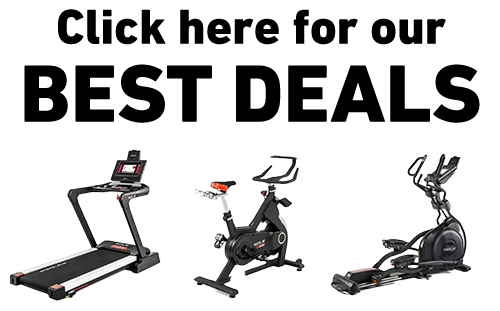Key Takeaways
- The elliptical primarily targets the glutes, hamstrings, quads, and calves.
- Upper body muscles such as the chest, shoulders, arms, and back are also engaged.
- Core muscles including the rectus abdominis, obliques, and erector spinae are activated.
- Adjusting resistance and incline on the elliptical can maximize muscle engagement.
- SOLE ellipticals offer customizable settings to enhance your workout.
|
At SOLE Fitness, we’re proud to offer the best treadmills for your home or gym. These machines are crafted to meet the highest standards of quality and performance, ensuring they are ideal for anyone - from fitness novices to seasoned athletes. Featured Products SOLE Ellipticals: Priced from $1,199.99, SOLE ellipticals are known for their ergonomic design, durability, and affordability. They provide a quiet, smooth workout with intuitive consoles, adjustable stride lengths, incline options, and heart rate monitoring, ensuring a comprehensive exercise experience. |
Elliptical machines are a popular choice for both cardio and muscle engagement, offering a full-body workout that targets a variety of muscle groups. Let's check out which muscles are worked on when you step onto an elliptical.
Upper Body Muscles
Chest
When you push the handles forward, you're working your chest muscles, which activates the pectorals, providing a good workout for the front of your upper body.
Shoulders
The shoulder muscles, including the deltoids, are engaged when you use the elliptical handles, helping to tone and strengthen the shoulders over time. Maintaining proper form ensures that your shoulders are engaged throughout the workout.
Arms
Your triceps and biceps get a workout too - when you pull the handles towards you, your biceps are engaged. Conversely, pushing the handles away works your triceps. This dual action ensures that both muscle groups are activated.

Back
The rhomboids and latissimus dorsi muscles in your back are engaged when you pull the handles towards you, as such, you strengthen your upper back, improving posture and overall strength.

Lower Body Muscles
Glutes
The gluteal muscles, or glutes, are heavily engaged when you use the elliptical: this is especially true if you increase the resistance or incline. Pushing down on the pedals activates the glutes, helping to tone and strengthen this muscle group.

Quads
Your quadriceps, or quads, are the muscles at the front of your thighs - they are activated every time you push down on the pedals. Increasing the resistance can further enhance the workout for your quads. For example, our SOLE ellipticals come with varying levels of incline and resistance that you can adjust to get the best lower body workout.
- E25: 20 lbs flywheel weight, 20 resistance levels, 20 incline levels
- E35: 25 lbs flywheel weight, 20 resistance levels, 20 incline levels
- E95: 27 lbs flywheel weight, 20 resistance levels, 20 incline levels
- E95S: 30 lbs flywheel weight, 20 resistance levels, N/A incline levels
- E98: 32 lbs flywheel weight, 40 resistance levels, 20 incline levels
Calves
Your calves, or gastrocnemius and soleus muscles, are also activated when you use the elliptical; every time you push down on the pedals, these muscles are engaged, helping to tone and strengthen the lower part of your legs.

Core Muscles
While the elliptical primarily targets the upper and lower body, it also engages your core muscles - these muscles are essential for maintaining balance and proper posture during your workout.
 Here’s the collection of core muscles (image courtesy of Fitpage).
Here’s the collection of core muscles (image courtesy of Fitpage).
Rectus Abdominis
The rectus abdominis, commonly known as the "six-pack" muscles, are engaged as you maintain an upright posture, helping to stabilize your torso and improve core strength.
Obliques
Your oblique muscles, located on the sides of your abdomen, are also engaged during an elliptical workout. These muscles help with twisting and turning motions, contributing to a well-rounded core workout.
Erector Spinae
The erector spinae muscles, which run along your spine, are activated to help maintain an upright posture, strengthening your back and also improving overall stability and balance.
Tips for Maximizing Muscle Engagement
Proper Form
Maintaining proper form is crucial for engaging the right muscles; keep your back straight, shoulders relaxed, and avoid leaning on the handles. This ensures that your muscles are working efficiently and reduces the risk of injury.
Adjusting Resistance and Incline
One of the best ways to maximize muscle engagement is by adjusting the resistance and incline settings on your elliptical - increasing the resistance makes your muscles work harder, while adjusting the incline targets different muscle groups. For example, a higher incline will engage your glutes and hamstrings more.
Incorporating Interval Training
Interval training involves alternating between periods of high intensity and low intensity, boosting your cardiovascular fitness and engaging different muscle groups. Try incorporating short bursts of high resistance followed by periods of lower resistance to keep your muscles challenged.
Common Mistakes to Avoid
Poor Posture
Slouching or leaning on the handles can reduce the effectiveness of your workout and increase the risk of injury. Always maintain an upright posture with your shoulders relaxed and your core engaged.
Ignoring Resistance Settings
Using the same resistance setting for every workout can lead to a plateau, so it’s essential to vary the resistance to keep your muscles challenged and to continue making progress.
Not Using Handles Properly
Failing to use the handles correctly can result in an incomplete workout - as such, make sure to push and pull the handles to engage your upper body muscles effectively.

Work Your Muscles with SOLE Ellipticals
The elliptical is an excellent tool for a full-body workout, engaging both upper and lower body muscles, and the core. By understanding which muscles are targeted and how to maximize their engagement, you can make the most of your elliptical workouts.
SOLE ellipticals offer customizable settings that allow you to adjust resistance and incline, ensuring that you can tailor your workout to your specific fitness goals. Investing in a SOLE elliptical means investing in a versatile, effective, and low-impact workout option that can help you achieve a balanced and comprehensive fitness routine.
If you already have a SOLE elliptical, try incorporating the tips and techniques discussed above to maximize your muscle engagement and enhance your workout.
Frequently Asked Questions (FAQ)
Is the elliptical effective for weight loss?
Yes, the elliptical is effective for weight loss. You get to experience a cardiovascular workout that burns calories, helping you to lose weight when combined with a healthy diet. To maximize weight loss, consider incorporating interval training and adjusting the resistance settings to keep your workouts challenging.
Can I build muscle with the elliptical?
While the elliptical primarily provides a cardiovascular workout, it also engages various muscle groups, helping to tone and strengthen them. Adjusting the resistance and incline can further enhance muscle engagement.
How many calories can I burn on an elliptical?
The number of calories burned depends on factors such as your weight, intensity, and duration of the workout. On average, a person can burn between 270 to 400 calories in a 30-minute session - by increasing the resistance and incorporating interval training, you can burn more calories. Using a heart rate monitor can also help you track your calorie burn more accurately.
Should I use the handles on the elliptical?
Yes, using the handles on the elliptical engages your upper body muscles, providing a more comprehensive workout. Pushing and pulling the handles helps to work your chest, shoulders, arms, and back. Make sure to use the handles correctly to maximize muscle engagement and avoid strain.
Is the elliptical good for beginners?
Yes, the elliptical is an excellent option for beginners; newbies get to enjoy a low-impact workout that is easy on the joints, making it suitable for people of all fitness levels. Beginners can start with lower resistance settings and gradually increase the intensity as their fitness improves.



Leave a comment
This site is protected by hCaptcha and the hCaptcha Privacy Policy and Terms of Service apply.